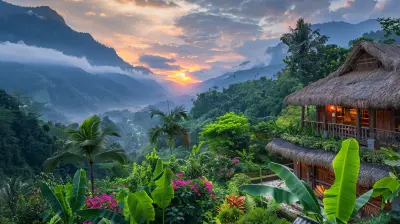Following Lost Trails: Tracking Ancient Trade Routes
11 August 2025
Have you ever wondered what it would be like to walk in the footsteps of ancient traders, merchants, and explorers? Imagine retracing the same paths where silk-laden camels once trod, or standing at the crossroads where civilizations met, exchanged goods, and shaped the world as we know it. Ancient trade routes are more than just dusty roads from the past—they are a living testament to human ambition, ingenuity, and adventure.
If you're a history buff or a curious traveler, following these lost trails is like stepping back in time. Let's journey through some of the most legendary trade routes and uncover the secrets they hold.
![]()
The Lifelines of Civilization
Before modern highways and shipping lanes, trade routes were the arteries of civilization. They connected distant cultures, enabled the exchange of goods, and spread ideas across continents. These routes weren’t just about commerce; they were the highways of human progress.Some of the most famous trade routes include:
- The Silk Road – Spanning Asia, the Middle East, and Europe
- The Spice Route – A maritime path linking Asia, Africa, and Europe
- The Amber Road – Connecting the Baltic region to the Mediterranean
- The Incense Route – Used for trading frankincense and myrrh across the Arabian Peninsula
- The Trans-Saharan Trade Route – Linking West Africa to the Mediterranean world
Each of these routes was a melting pot of cultures, fostering interactions that shaped history.
![]()
The Silk Road: A Web of Commerce and Culture
The Silk Road wasn’t just one road—it was an intricate network of land and sea routes stretching from China to the Mediterranean. Named for the lucrative silk trade from China, this route facilitated the exchange of goods like spices, precious stones, ceramics, and even paper.But trade wasn’t the only thing moving along these routes. Languages, religions, and technologies spread like wildfire. Buddhism made its way from India to China, while paper-making techniques traveled westward, revolutionizing communication in Europe.
Must-Visit Stops on the Silk Road
If you're thinking of tracing this legendary route, here are some must-visit locations:- Samarkand, Uzbekistan – A city filled with stunning Islamic architecture and history
- Dunhuang, China – Home to the famous Mogao Caves, filled with ancient Buddhist art
- Istanbul, Turkey – Where the East meets the West, a bustling metropolis packed with history
![]()
The Spice Route: The Ocean’s Treasure Trove
Long before the days of supermarkets, spices were worth their weight in gold. The Spice Route was a maritime network that connected Asia, the Middle East, and Europe, facilitating the trade of spices like cinnamon, black pepper, nutmeg, and cloves.Indonesia’s Maluku Islands, also known as the 'Spice Islands,’ were the epicenter of this trade. European explorers risked life and limb to reach these islands, drawn by the immense value of their aromatic treasures.
Must-Visit Stops on the Spice Route
- Goa, India – Once a major trading hub for Portuguese merchants- Zanzibar, Tanzania – A historic spice-trading center known as the “Spice Island”
- Malacca, Malaysia – A crucial trading post where East met West
![]()
The Amber Road: Trading Nature’s Gold
Not all trade revolved around silk and spices. The Amber Road, stretching from the Baltic region to the Mediterranean, was an ancient network used to transport amber, often called “gold of the North.”Amber, highly prized by the Romans for its beauty and supposed mystical properties, found its way from the frigid shores of the Baltic Sea to the grand marketplaces of Rome.
Must-Visit Stops on the Amber Road
- Gdańsk, Poland – A city famous for its amber craftsmanship- Vienna, Austria – A historic stop along the trade route
- Aquileia, Italy – An ancient Roman city that was once a major commercial center
The Incense Route: The Scented Path to Wealth
The Incense Route was an ancient network of land and sea trade routes used primarily for transporting frankincense and myrrh from the Arabian Peninsula to the Mediterranean. These aromatic resins were highly sought after for religious rituals, medicine, and even embalming.The harsh deserts of Arabia made this route perilous, but traders braved the elements in camel caravans that transported these fragrant treasures to Egypt, Rome, and beyond.
Must-Visit Stops on the Incense Route
- Petra, Jordan – Once a thriving trade hub for incense and spices- Shibam, Yemen – Known as the "Manhattan of the Desert" due to its ancient skyscrapers
- Alexandria, Egypt – A major port where goods from the East met the Mediterranean world
The Trans-Saharan Trade Route: Gold, Salt, and Empires
The Trans-Saharan Trade Route was a vast network that connected West Africa to North Africa and the Mediterranean. This route was primarily used for trading gold, salt, ivory, and slaves.The wealth amassed through this trade helped powerful African empires like Mali and Ghana flourish. The legendary city of Timbuktu became a center for trade and Islamic scholarship, attracting scholars and merchants from all over the world.
Must-Visit Stops on the Trans-Saharan Trade Route
- Timbuktu, Mali – A historic city filled with ancient manuscripts and mosques- Ghadames, Libya – An ancient desert town known for its unique architecture
- Marrakech, Morocco – A vibrant city that was a key stop along the trade route
The Legacy of Ancient Trade Routes
Ancient trade routes weren’t just about selling goods; they were highways of culture, knowledge, and innovation. They connected empires, spread religions, and even influenced modern geopolitics.Many of the cities that once thrived along these routes are now UNESCO World Heritage Sites, preserving the legacy of trade and travel. For modern adventurers, retracing these lost trails offers a glimpse into a time when merchants, monks, and explorers roamed the world, shaping the course of history.
Walking these ancient paths today is like reading the pages of a living history book—you don’t just learn about the past, you experience it.
Final Thoughts
If you're craving an adventure that combines history, culture, and travel, why not take a journey along these ancient trade routes? Whether you’re wandering through the bustling bazaars of Istanbul, trekking the Silk Road, or sailing the Spice Route, you’ll be following in the footsteps of the traders and explorers who helped shape our world.So, are you ready to follow the lost trails? Pack your bags, grab a map, and let history be your guide.
all images in this post were generated using AI tools
Category:
Off The Beaten PathAuthor:

Claire Franklin
Discussion
rate this article
2 comments
Maura Garcia
Exploring ancient trade routes offers a unique glimpse into history and culture. These lost trails not only connect us to our past but also guide modern travelers through breathtaking landscapes and forgotten towns. Don’t miss the chance to wander where history once thrived!
November 1, 2025 at 5:40 AM

Claire Franklin
Thank you for your insightful comment! Exploring these ancient trade routes truly enriches our understanding of history while revealing stunning landscapes. Happy wandering!
Sable Gomez
What an exciting journey through history! Exploring ancient trade routes brings vibrant stories and cultures to life. Can't wait to wander these lost trails and uncover the treasures they hold! Happy travels! 🌍✨
August 14, 2025 at 3:49 PM

Claire Franklin
Thank you! I'm thrilled you enjoyed the journey through these fascinating trade routes. Happy exploring! 🌍✨


